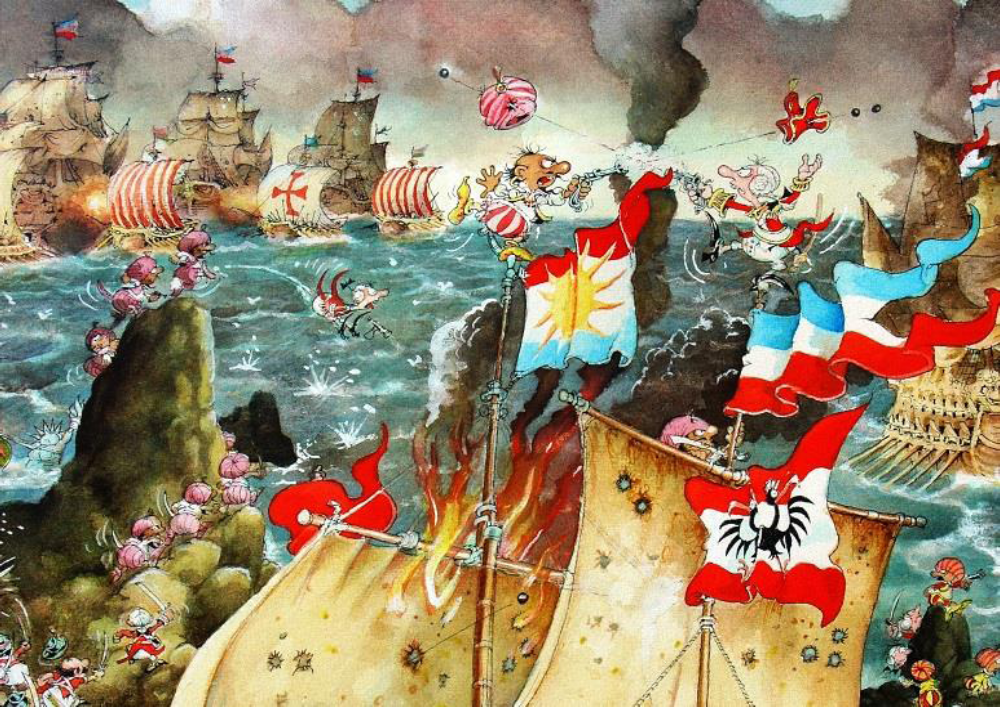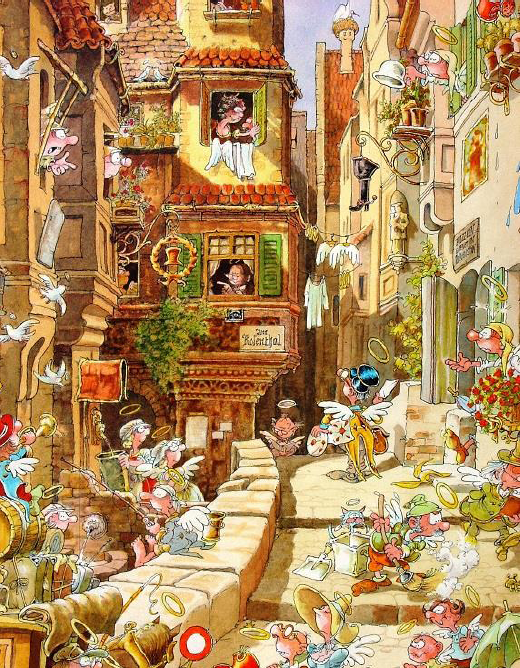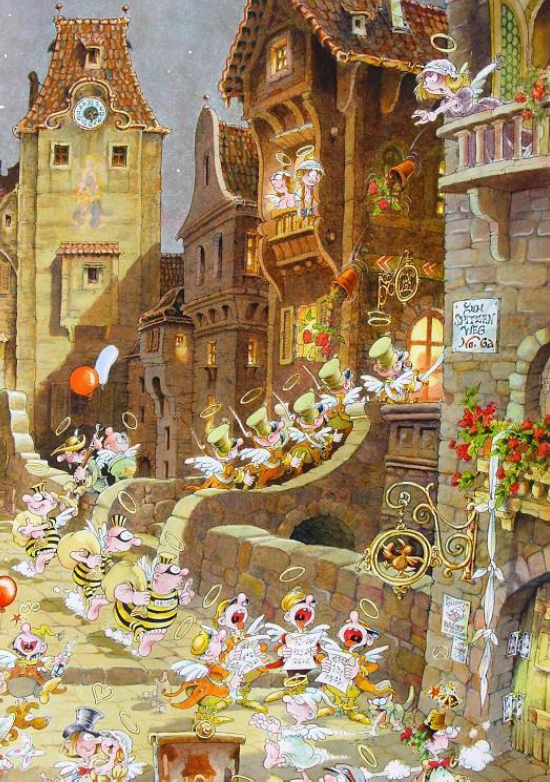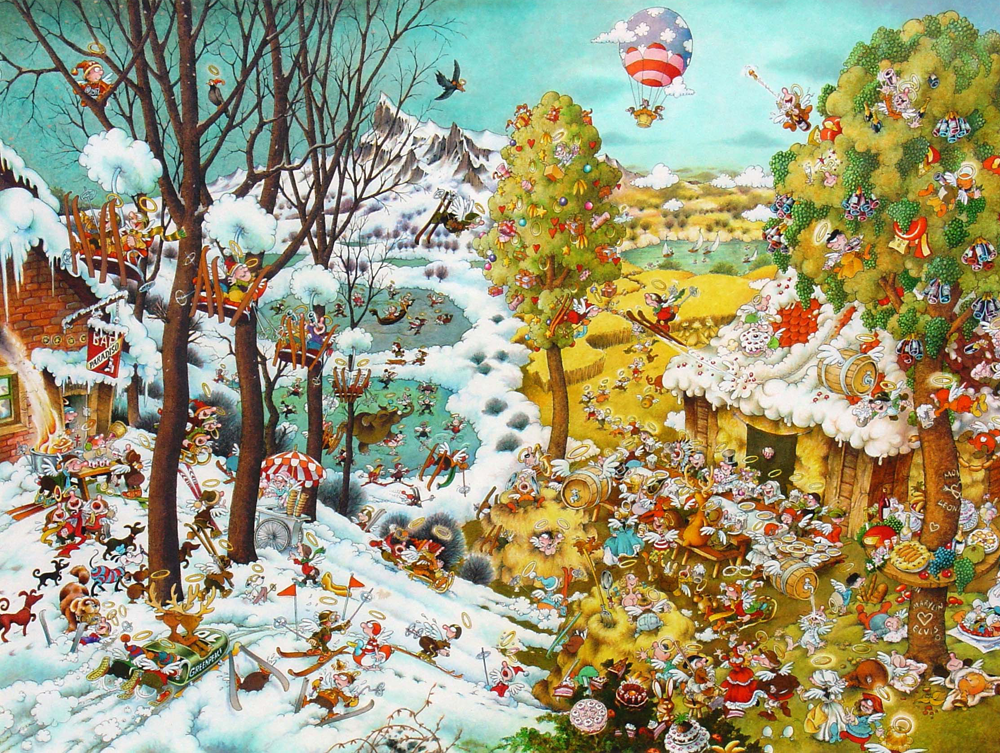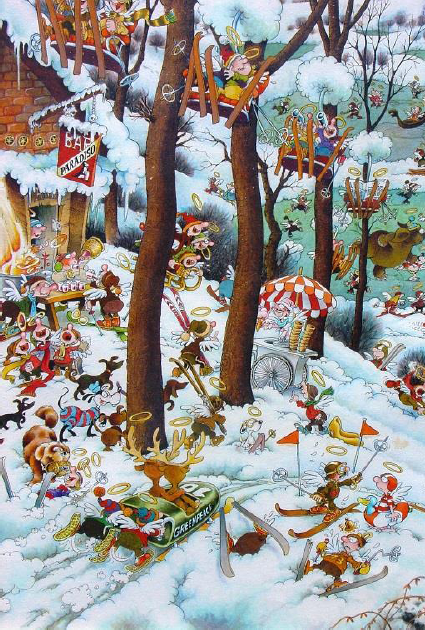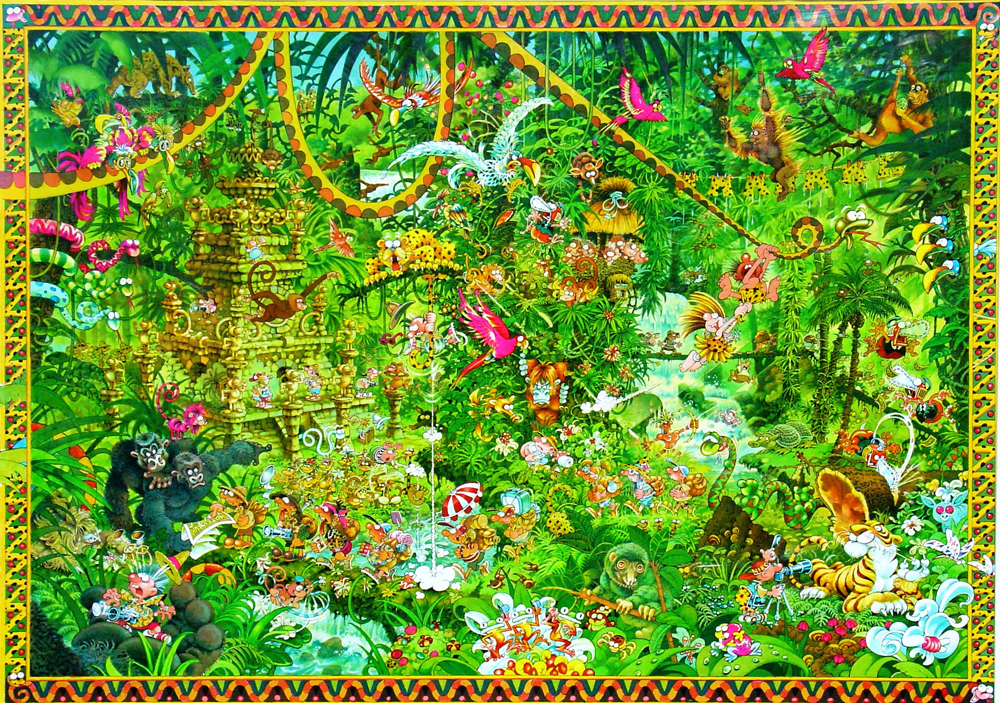by Dr. Richard Herzog, Berlin
Michael Ryba is one of the leading representatives of cartoon art. This new art genre that originated around 1980 combines the humorous motifs of cartoons and the masterly execution of high-ranking works of art.
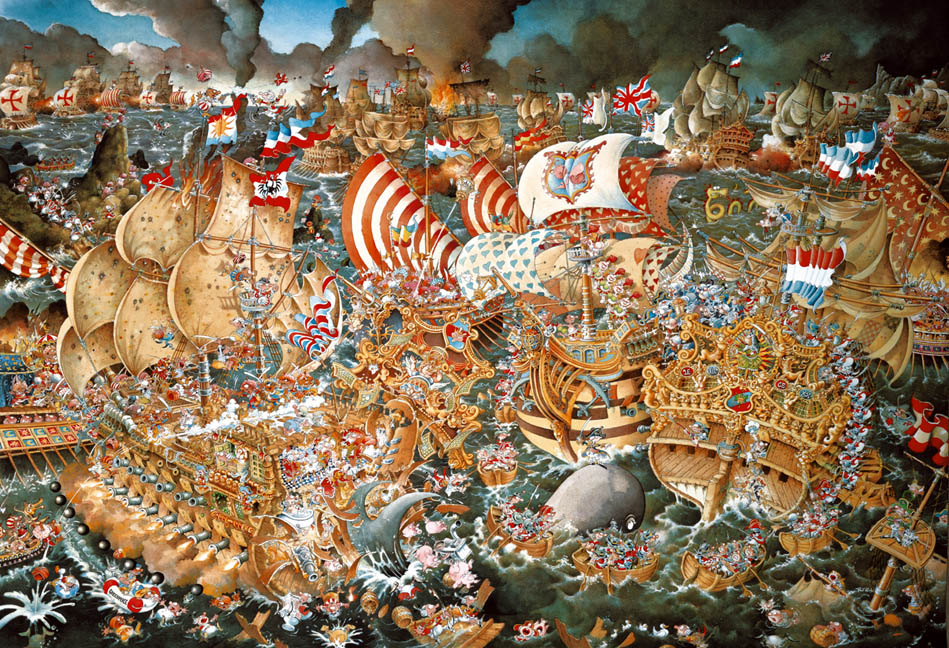
Fig. 1: Ryba: “Trafalgar“
“Cartoons” and “works of art” were completely separated from each other in the past, and for a long time it seemed as if paintings turned inferior by the sheer presence of a humorous content. Art – this was an enduring erroneous concept – had to be grave and serious, because only something really serious could apparently be “high art”. Even the depicted motif influenced the status of a painting. Thus the five most important genres had a clear ranking:
“History painting” was top-ranking for many centuries; it devoted itself to historical events (like battles), as well as to mythological and religious topics. “Portraits” were also considered high art, especially because kings, their families, and other rulers were depicted. “Landscapes” and “genre painting” followed at a great distance; genre paintings depicted subjects and scenes from everyday life, ordinary folk, and common activities. Finally, “still life” that showed only “dead things” was found at the bottom of the hierarchy. Thus it is not astonishing that a still-life painter could become a member of the “Académie Royale de Peinture et de Sculpture” in Paris but – unlike a history painter – was not allowed to educate disciples. Even an artistically poor representation of the Virgin Mary was still classified much higher than a brilliant still life depicting fruits or flowers.
Many of those educated in this spirit rejected the representation of humor in paintings, if the latter were to be considered works of art. “Humor” was considered incompatible with art even a few decades ago and was stereotypically categorized “comics = cheap magazine = inferior”. This view changed in the 1960s through Pop Art, which challenged existing conventions. Even the world of comics – frowned on up to that time – made its way into art with Roy Lichtenstein. Humor in art was not a taboo any longer, especially in the USA; the process required a longer time in Europe.
Cartoon art is a synthesis of the world of cartoons and traditional paintings. lt takes the motifs, the humor, and the graphic elements from cartoons and the motifs, composition, and execution from traditional paintings. Cartoon art pictures are subject to the same quality criteria as any other work of art.
Michael Ryba is one of the founders of this art genre and one of its leading representatives worldwide. He shaped cartoon art from the very beginning and introduced the characteristic elements of Dutch art of the 16th and 17th centuries to this genre.
Four examples described in this article exemplify Ryba’s work.
“Trafalgar” (Fig. 1-4) humorously depicts the battle of Trafalgar off the coast of southern Spain in 1805, in which the British fleet under Admiral Nelson defeated the Napoleonic fleet. Without the cartoon elements, the motif would make this a typical history painting. The humor in the painting relaxes the situation and deprives the battle of its fright. By using humor, Ryba achieves the representation of a historical event associated with bloodshed and death without any pathos, glorification, or partisanship for either side. In none of the depicted scenes does the viewer fear that the depicted persons could really be at risk.
Ryba’s “Trafalgar” is the first funny battle painting in the history of art. At the same time, it casts doubt upon the basic foundation of history painting. Is it possible or allowed to represent an important historic event that shaped world history without heroism and pathos? Ryba just does it and thus questions the predominant importance of “history painting” as the top-ranking art genre for many centuries.
“Trafalgar” is strongly influenced by the Dutch marine paintings of the 17th century. lt cites the paintings of Hendrick Vroom, who also painted a naval battle near Cádiz (in southern Spain), and of Cornelis Claesz van Wieringen, who depicted the naval battle of Gibraltar in 1607 in a series of paintings (the most famous one is a picture depicting the explosion of the Spanish admiral’s boat). In Ryba’s painting, one can see the rock of Gibraltar in the right upper corner of the painting. With respect to the distribution of light and dark in the picture, however, “Trafalgar” reminds one of the naval battles of Ludolf Backhuysen and Willem van de Velde.
Besides the very naturalistic representation of the warships, the whale in the front of Ryba’s painting deserves special attention, since no whale intervened in the battle of Trafalgar. This element is a further citation of Dutch marine paintings; Abraham Storck was the predominant representative of Dutch whaling pictures.
Ryba succeeds in conveying the muddle and confusion of the battle. The ships in the foreground fuse to form a unit, making it difficult to tell friend from foe. Only the ships’ flags and the uniforms of the crews permit attribution. Whereas historiography represents the view of the winner and history painting submits to this procedure and takes the winner’s side, Ryba makes a different political statement in his history painting: for him there are no winners or losers.
Another of Ryba’s paintings plays a very predominant role, not only in cartoon art but also in painting in general. Ryba makes art history with his landscape “Romantic Town” (Fig. 5), since he accomplishes something new: he represents the complete work of another artist in a single painting. This is something that did not exist before Ryba.

Fig. 5: Ryba: “Romantic Town“
Although it is common to cite the work of other artists (for example, there are numerous variations of Leonardo’s “Mona Lisa”), almost always only a single picture is cited. In “Romantic Town”, about 50 paintings by the Biedermeier artist Carl Spitzweg (1808-1885) are cited. The peculiarity is that a harmonious general picture is created. Precisely the desire for harmony is why almost always only one picture and in very rare cases two paintings are reproduced or altered. lt is very difficult to combine just three or four paintings so that they fit and do not seem artificially put together. Thus Ryba’s painting is an impressive example of compositional ability. Only by completely absorbing Spitzweg’s work and by thinking and feeling like him does Ryba succeed in creating a correct and harmonious overall painting.
An important means to achieve this goal is the composition of the painting. The picture shows a square with a row of houses in the center; streets to the left and right of these houses lead to the background. At the left and right margins, additional rows of houses are found. In the houses, on the streets, and on the square we find the motifs familiar from Spitzweg’s paintings. In some cases, they are easily recognized, like “The Intercepted Love Letter” (Fig. 6-7) or “The Professor” in the left-hand house, “Postman in Rosenthal” (Fig. 8-9) or “Sunday Afternoon Stroll” on the left-hand street, and “The Quartet” (Fig. 10-11) on the right-hand side. The better-known motifs “The Poor Poet” and “The Bookworm” are more hidden and can be found in the windows of the house in the center of the picture (Fig. 12-14). Other motifs represent two Spitzweg paintings at the same time, like “On the Roof”/”The Cactus Friend” to the left of the poor poet; in contrast to Spitzweg’s picture, cacti instead of flowers are being watered. In addition, other Spitzweg paintings are reinterpreted. For example, in Spitzweg’s “Catching Butterflies”, one person deals with two butterflies, whereas in Ryba’s picture the ratio is inverted and two people are behind one butterfly.
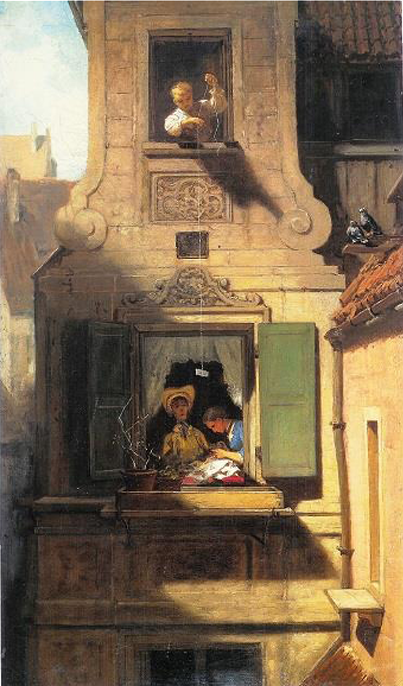
Fig. 7: Spitzweg: “The Intercepted Love Letter“


Fig. 9: Spitzweg: “Postman in Rosenthal“

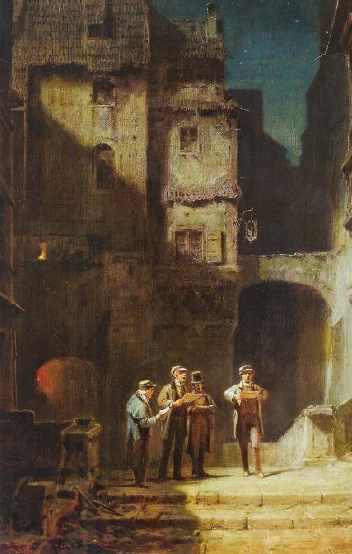
Fig. 11: Spitzweg: “The Quartett“

A good example of the humor in the painting can be found in the motif “The Quartet” on the right of “Romantic Town”. Ryba expands on Spitzweg’s painting and has the woman, molested by the nightly noise, throw flowerpots on the singers (thereby hitting an innocent bystander). And even one of the rogues who committed a robbery and leaves with his loot feels the moral obligation to hint at the quartet’s improper behavior and to appeal to the singers for silence. This is even intensified by the fact that “The Patrol”, depicted in many of Spitzweg’s paintings, marches out of the picture to the right without paying attention to the robbers and disturbers of the peace and that another of Spitzweg’s motifs, “The Sleeping Night-watchman”, sleeps in spite of the noise.
Ryba wants to express that not everything was only good “in the good old days”. Using humor, however, he wants to tell us at the same time that the Biedermeier period in Germany (about 1815 to 1848) was less tranquil and contemplative than we now believe. The vertical bisecting line in the picture (represented by the row of houses in the center) results in a symmetrical composition of the painting. By means of this symmetry, Ryba achieves a balance and brings tranquility into the picture that would otherwise appear too confused due to the great number of depicted motifs. This symmetrical composition enables Ryba to make something possible that seemed to be impossible:
Spitzweg is known for the night or moonlight paintings that he created in addition to his daylight pictures. Ryba places the daylight motifs at the left and the night motifs at the right of his own picture. Therefore we get a day sky in the upper left and a night sky in the upper right. This is a very elegant solution to simultaneously depict the motifs that take place at different times of the day.

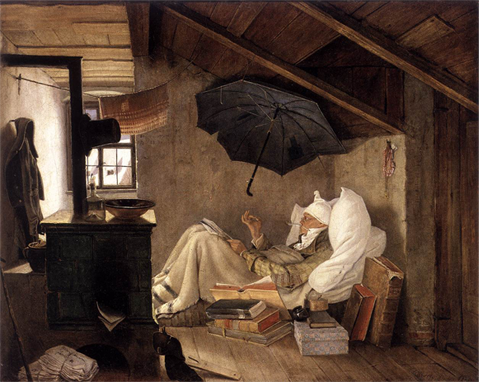
Fig. 13: Spitzweg: “The Poor Poet“
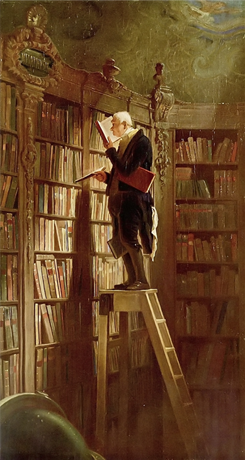
Fig. 14: Spitzweg: “The Bookworm“

“Trafalgar” and “Romantic Town” suffice to display the high artistic quality achieved
by paintings belonging to cartoon art.
A different painter is dealt with in the picture “Schlaraffia” (also known as “Paradise an Earth“) (Fig. 15). Ryba varies here pictures by the Dutch painter Pieter Bruegel (1525-1569). Again, by using a symmetrical composition, he combines a winter landscape (to the left) with a summer/fall landscape (to the right). In contrast to “Romantic Town”, Ryba purposely does not depict the complete work of Bruegel in “Schlaraffia”. Characteristic of this Dutch artist’s paintings was the multitude of depicted persons; we speak of Bruegel’s “teeming pictures”. That means transferring the concept implemented in “Romantic Town” to “Schlaraffia” would result in hopeless confusion. Thus Ryba restricts himself to depicting a few well-known pictures that can be easily identified and cites further motifs in a concealed way.

lt is easy to find Bruegel’s motif “Hunters in the Snow” (Fig. 16-17) on the left and the motifs “The Harvesters”, “Peasant Wedding”, and “Peasant Dance” on the right as well as “The Land of Cockayne” (Fig. 18-20) in the lower right corner. There are additional citations of pictures like “The Census at Bethlehem”, “Wedding Dance”, and “The Fight between Carnival and Lent”, of which individual incidental elements of the pictures are transferred to and hidden in “Schlaraffia”. Ryba thus transforms his Bruegel painting into a puzzle picture whose solution requires a good knowledge of Bruegel’s paintings.


Fig. 17: Bruegel: “Hunters in the Snow“


Fig. 18: “Paradise on Earth “ (fragment)

Fig. 19: Bruegel: “Peasant Wedding“
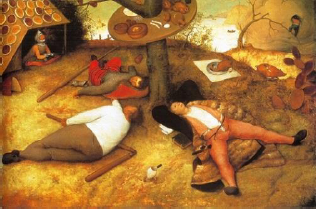
Fig. 20: Bruegel: “The Land of Cockayne“
 Much more confusing than Ryba’s Spitzweg and Bruegel paintings is his work “Amazonas” (Fig. 21). Ryba chooses a composition that offers no anchorage. All parts in the painting are equal and the eye moves aimless from one part to the other to get an overall impression. Thus the artist evokes the effect of feeling lost, as in the real jungle: due to the dense vegetation, one easily loses one’s orientation in the jungle and one continuously looks for a reference point.
Much more confusing than Ryba’s Spitzweg and Bruegel paintings is his work “Amazonas” (Fig. 21). Ryba chooses a composition that offers no anchorage. All parts in the painting are equal and the eye moves aimless from one part to the other to get an overall impression. Thus the artist evokes the effect of feeling lost, as in the real jungle: due to the dense vegetation, one easily loses one’s orientation in the jungle and one continuously looks for a reference point.
To intensify this effect, Ryba uses two additional artistic tricks in “Amazonas”. First, he places the motifs one next to the other and purposely omits the depth that offers a starting point to know which objects are closer and which are farther away. This can only be deduced from the size of the 57 persons and 129 animals depicted in the picture, by comparing each mentally with the size experience leads one to suspect. Second, Ryba uses to bewilder colors in “Amazonas”. Green and yellow dominate and are evenly distributed over the whole surface. The other colors are also dispersed over the picture without forming a focus that could serve as an orientation point. This color distribution contributes to the confusion in the picture. At least the predominance of green as a calming color partially achieves a compensation for the restlessness.
Ryba provokes a feeling of being lost in the picture as in the real jungle to induce the viewer to pay more attention to the details. Thus, on the right-hand side, one can find the jungle destroyers, represented by odd birds wearing suits and having chainsaw heads that excrete banknotes and coins (Fig. 22). Ryba thus not only depicts the idyllic aspect of the jungle, but also hints at an outrage in our world. Whereas the two swallowed tourists whose silhouettes can be seen in the big snake to the left of the cut down tree still have a humorous effect, Ryba does not endow the chainsaw figures with any positive attribute. The social condemnation of ecocide becomes a serious issue for him.

Fig. 22: “Amazonas“ (fragment)

In “Amazonas” the balance between graphic and painting elements in the picture becomes evident. If only the drawings made with ink were reproduced, no jungle feeling would arise. On the other hand, if only the parts painted in watercolors were represented, the picture could not be recognized. Thus Ryba achieves in “Amazonas” the rare effect that drawing and painting are equivalent: “Amazonas” is neither a colored drawing nor a pure painting without contours (Fig. 23). This is unusual, since either the linear style or the painterly style generally predominate in pictures. The linear style is based on the drawing scaffold, and the contours are clearly visible. (Examples of this style are the pictures of Dürer, the Renaissance, or Classicism). In the painterly style, on the contrary, the contours are unpronounced to dissolved and masses replace the lines. (Examples of this style are the pictures of Rembrandt, the Baroque, and lmpressionism). As “Amazonas” shows, however, these two contradictory worldviews on how to build a picture are compatible and can both be represented as equals in a picture.

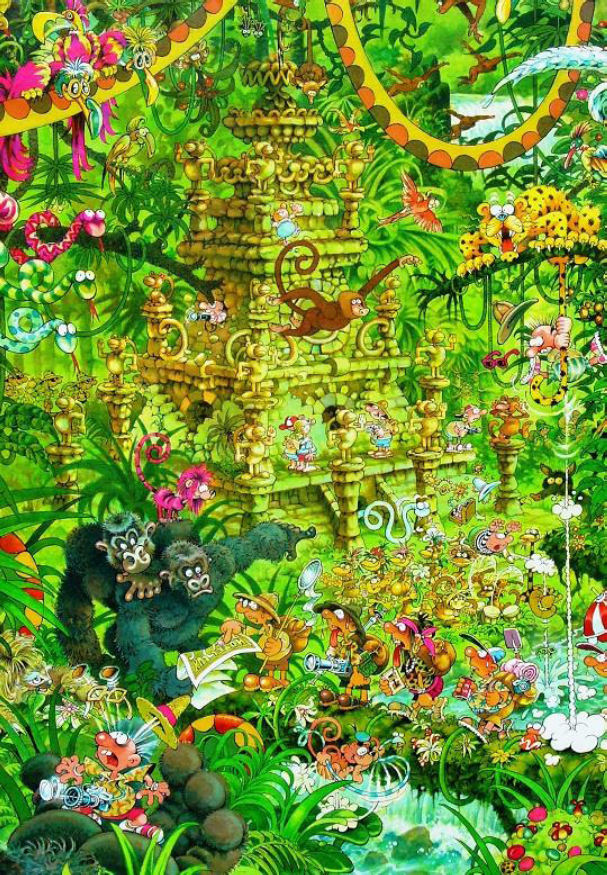
Fig. 23: “Amazonas“ (fragment)

Ryba’s cartoon art is very comprehensive and encompasses a multitude of different motifs: from history painting, as in “Trafalgar” or “Go West” (the depiction of the meeting of the Central Pacific and the Union Pacific railroads in the USA in 1869), through landscapes and the painting of a metropolis like “New York” or “Berlin”, to events from daily life and the narration of a detective story in several scenes in “Who did it?” The humor in the pictures is evident, but is only one element. Much more important are the sometimes unusual compositions and the high-ranking artistic execution of the paintings that result in their singularity. The creation of the pictures with their wealth of details is an extremely arduous labor taking many months, already due to their size (up to 190 x 136 cm). The obtained results, however, prove that this work is worth-while; unusual pieces of art are created.
Cartoon art has achieved a high degree of maturity. Ryba’s cartoon art pictures are based on the tradition of the Dutch “teeming paintings”, with all their depicted figures, as in the work of Hieronymus Bosch (ca. 1450-1516), Pieter Bruegel, and Hendrik Avercamp (1585- 1634). Many of Ryba’s paintings demonstrate that he is obliged to this Dutch painting style. His pictures, however, go beyond this and contain further components from various styles and (this is the peculiarity) his own creations.
Of all existing cartoon art pictures, Ryba’s are the most complex and the compositionally most demanding ones. Ryba is without doubt the leading master of Cartoon Art. He entered unchartered territory and created a new type of work of art. This explains and justifies Ryba’s special place in the history of art.
(This article was originally printed in “Art Scene International” in 2005.)
Download Ryba and Cartoon Art by Richard Herzog PDF

